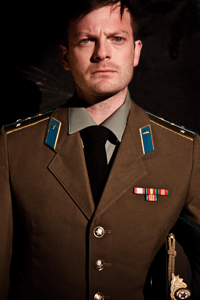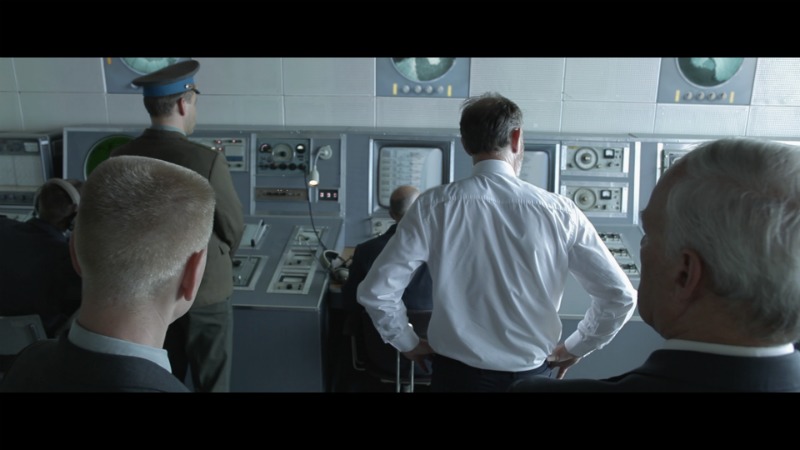“The Cosmonaut” seems to be an unstoppable project. When the Russian backer pulled out (along with half of the funds) just days before shooting began, the team raised €120,000 in three days through crowd-funding. Nor were the inexperienced crew deterred by the plague of mosquitoes they encountered on location in Latvia, insects ferocious enough to kill a local cow and to make actor Max Wrottesely’s leg turn black. It may even have had a positive effect on the film. Wrottesely himself seems to have taken it in his stride: “nothing creates camaraderie like chaos”.
“The Cosmonaut” seems to be an unstoppable project. When the Russian backer pulled out (along with half of the funds) just days before shooting began, the team raised €120,000 in three days through crowd-funding. Nor were the inexperienced crew deterred by the plague of mosquitoes they encountered on location in Latvia, insects ferocious enough to kill a local cow and to make actor Max Wrottesely’s leg turn black. It may even have had a positive effect on the film. Wrottesely himself seems to have taken it in his stride: “nothing creates camaraderie like chaos”. And it seems that neither were national borders any obstacle in the making of this ambitious, cybernautic project. The opening – with a man talking in Italian about USSR rockets detected by German receivers – only adds to the exciting cultural mix of a Spanish-based production with a largely Anglophone cast, filmed in Latvia.

.
There is certainly a lot to like about The Cosmonaut. The cinematography is simply beautiful, reminiscent of geographical documentaries such as Samsara in the use of breath-taking images that almost speak for themselves. In fact, once they are combined these images ask eloquent questions of the audience. A close-up of the ring of a gas stove followed by the roaring exhaust of a space rocket, for example, leads us to contemplate the size of the universe. The film is delightful in its attention to detail and symbolism; minutiae such as photographs, mirrors and recurring emblems give the viewer clues that must surely become more meaningful with each viewing.
But this may not be enough to please everyone; such detail and lyricism makes the film very hard work. There was certainly more than one audience member left perplexed when the lights came up, and as Candole herself says “the film on its own doesn’t really quite work […] I was in it and I don’t really understand it.” Wrottesley agrees: there is a need to balance accessibility with the art-house approach, and neither are convinced that this has been achieved in “The Cosmonaut”. This is merely a matter of opinion, though, and those who enjoy experimental film will be delighted by Alcalá’s directorial debut. And it is important to remember, of course, that this is not intended to be a traditional stand-alone feature film. This is an innovative transmedia project and there are 32 more short films online which we are assured will answer the burning questions the audience are left with. Scrawled across my own notes is the musing, “What actually happens? Is it all just a big metaphor?”
The truly burning question is, does the film do enough to convince us to go in search of these answers? I’m honestly not sure. The rather obtuse approach certainly makes it difficult to warm to the characters. This is particularly true of the love-interest, Yulia, who comes across not so much as a character but as a plot device inserted to wreak havoc on the friendship of Stas and Andrei. There is little to laud or to criticise in the performance of the actors themselves; they weren’t really given much of a chance to show what they are made of amongst the charismatic locations and the disconcerting dream-like atmosphere that pervades the film.
If you want a straightforward Hollywood-style narrative then The Cosmonaut is probably not for you. But, then again, the more than 4,000 individuals who funded such an unconventionally produced project were surely looking for anything other than standard fare. When I came out of the cinema, I was rather in need of a Cosmonaut cocktail to bring me back to earth.
If it’s a straightforward, Hollywood-style narrative that you’re after, then “The Cosmonaut” probably isn’t for you. But, then again, the more than 4,000 individuals who funded such an unconventionally produced project were surely looking for anything other than standard fare. I must admit to feeling the need for a Cosmonaut cocktail to bring me back to earth after leaving the cinema, perhaps to help me to get over my initial disappointment that such a fascinating project had led to such an unsatisfying film. I was also convinced that I would never bother to revisit the inhabitants of Star City by seeking out the rest of the material. I had no emotional connection with any of the characters, and none of the feeling of catharsis that should come at the end of a great story. So I am surprised to find that the mysteries of The Cosmonaut are still playing on my mind. As a member of the YouTube generation, it has not yet been quite enough to persuade me to pay for the privilege but I do feel more and more inclined to return to the feature film itself and the small number of other fragments that are available to watch free online. And the footage behind the paywall? I think I probably will get round to seeing it… eventually.
Read more about the role of transmedia, creative commons and more in The Cosmonaut: http://en.cosmonautexperience.com/

